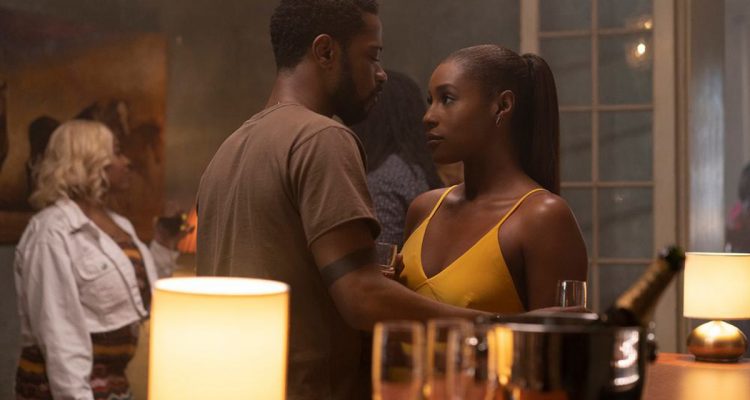Valentine’s Day is for lovers, as is the V-Day weekend excursion to the theaters where studios have typically offered their latest in various modes of romance, be it comical, sensual, dramatic, or otherwise. Universal Picture’s entry, “The Photograph,” certainly has its fair share of steam, sexy actors and soapy melodrama. Despite the diminution of the romantic genre on-screen (Uni, the only major studio presenting such fare this year), much of it seemingly moved to Netflix and other streaming platforms, director Stella Meghie tries to bring sexy back with “The Photograph.” But her lovers—distancing, as they are never fully drawn— aren’t easy to fall for, and her woozy fantasy never finds sharp focus.
READ MORE: 100 Most Anticipated Films Of 2020
Part of the problem in this dreamy-looking movie is that these characters don’t feel like authentically written on any level and live in an imaginary movie fantasy word never tethered to reality. This is part of the contract, “The Photograph” strikes early on with its audience: become allured with the gauzy dreaminess, and forget yourself and the rest (of the plot and story that is barely there), but it rarely convincingly works.
READ MORE: The Best Animated Movies Of The Decade [2010s]
Michael (LaKeith Stanfield) is working for a magazine called The Republic. Assigned an article on Hurricane Katrina in New Orleans, there he meets Isaac (Rob Morgan), a fisherman who shows him a black and white photograph—a portrait of a photographer named Christina (Chante Adams), Isaac’s former girlfriend. This supposedly revelatory moment prompts Michael to find Christina’s daughter, Mae (Issa Rae), a museum curator who, like himself, lives a life of unhurried luxury despite having an ordinary job. How? And why exactly does he care so much about this random photographer? None of this is explained, and sure, Black narratives should be afforded these kinds of unrealistic movie conceits too. At the same time, we shouldn’t be any less forgiving to these unbelievable contrivances that take you out of the picture. Maybe, it’s best to go with the flow and let Mark Schwartzbard‘s cinematography do the talking, as “The Photograph” suggests early on.
READ MORE: The 25 Best Films Of 2019
New York City, as shot by Schwartzbard, is a dream come true. For audiences looking for escapist entertainment, this is the place to be. Art galleries are buzzing; crane shots swoop down from glamorous apartments to bustling streets, and golden-hour lighting makes raindrops pop like champagne bubbles. No wonder Mae and Michael are falling in love, the camera constantly creates a warm lovescape to fall for, but the movie provides little else. He asks her out to dinner. She seems nervous. “Just be yourself,” Michael tells her. “I don’t know who that is,” she replies. A couple of drinks and lots of ogling later, the two jam out to Al Green at her place, which eventually leads to the best we can ask for from this picture at this point: More Al Green, we receive it and sure, we’ll take what we can get.
READ MORE: The 100 Best Films Of The Decade
The movie, however, loses further steam during flashback sequences. As Michael reads over his interview with Isaac, and the letters Christina left for Mae, the events of the two’s break up play out on screen. While the shifting timelines makes for an interesting commentary on how the past repeats itself—are Mae and Michael doomed to repeat Issac and Christina’s mistakes?— it kills the narrative momentum. Worse, it kills the vibe “The Photograph” promised in the first place. You know, the one that said, sure there’s not much of a story or characters, but this lightheaded, intoxicating atmosphere will be enough for 90 minutes, right?
And that vibe is mostly all “The Photograph” has going for it. What Meghie lacks in pace and narrative structure, she almost makes up for in atmosphere and performances that can be transporting despite the thinness of the characters. At least these leads always seem like they’re organically in the moment, rather than reciting lines of dialogue. Credit the actors for that. Stanfield knocks his first major Hollywood starring role out of the park. He has proven he can carry a movie before in “Sorry to Bother You,” and carry scenes in “Get Out” and “Uncut Gems,” but here he officially becomes a “movie star.” His star turn, as with Rae’s, when it’s at its best, recalls Richard Linklater’s “Before Trilogy.”
Like Linklater’s masterpieces, the actors make a few key moments feel as if time has stopped, which is both freeing and crippling. Since they actually do have all the time in the world—both are rich and apparently can leave their jobs whenever—the most significant conflict they face is an argument about who’s better: Drake or Kendrick? Love may conquer all in the real world. But it can’t conquer privileged characters on screen where there are zero stakes of any kind and no narrative drive. Ultimately, no amount of champagne, pretty faces, and New York real estate porn can turn dull lovers and a dramatic lack of focus into a pretty picture, and this is the reality “The Photograph” captures in the end. [C]

